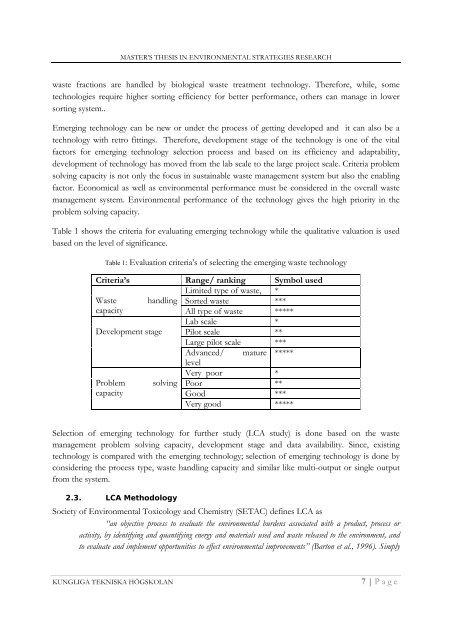Technical Development of Waste Sector in Sweden: Survey
Technical Development of Waste Sector in Sweden: Survey
Technical Development of Waste Sector in Sweden: Survey
Create successful ePaper yourself
Turn your PDF publications into a flip-book with our unique Google optimized e-Paper software.
MASTER’S THESIS IN ENVIRONMENTAL STRATEGIES RESEARCH<br />
waste fractions are handled by biological waste treatment technology. Therefore, while, some<br />
technologies require higher sort<strong>in</strong>g efficiency for better performance, others can manage <strong>in</strong> lower<br />
sort<strong>in</strong>g system..<br />
Emerg<strong>in</strong>g technology can be new or under the process <strong>of</strong> gett<strong>in</strong>g developed and it can also be a<br />
technology with retro fitt<strong>in</strong>gs. Therefore, development stage <strong>of</strong> the technology is one <strong>of</strong> the vital<br />
factors for emerg<strong>in</strong>g technology selection process and based on its efficiency and adaptability,<br />
development <strong>of</strong> technology has moved from the lab scale to the large project scale. Criteria problem<br />
solv<strong>in</strong>g capacity is not only the focus <strong>in</strong> susta<strong>in</strong>able waste management system but also the enabl<strong>in</strong>g<br />
factor. Economical as well as environmental performance must be considered <strong>in</strong> the overall waste<br />
management system. Environmental performance <strong>of</strong> the technology gives the high priority <strong>in</strong> the<br />
problem solv<strong>in</strong>g capacity.<br />
Table 1 shows the criteria for evaluat<strong>in</strong>g emerg<strong>in</strong>g technology while the qualitative valuation is used<br />
based on the level <strong>of</strong> significance.<br />
Table 1: Evaluation criteria’s <strong>of</strong> select<strong>in</strong>g the emerg<strong>in</strong>g waste technology<br />
Criteria’s Range/ rank<strong>in</strong>g Symbol used<br />
Limited type <strong>of</strong> waste, *<br />
<strong>Waste</strong> handl<strong>in</strong>g Sorted waste ***<br />
capacity<br />
All type <strong>of</strong> waste *****<br />
Lab scale *<br />
<strong>Development</strong> stage Pilot scale **<br />
Large pilot scale ***<br />
Advanced/ mature *****<br />
level<br />
Very poor *<br />
Problem solv<strong>in</strong>g Poor **<br />
capacity<br />
Good ***<br />
Very good *****<br />
Selection <strong>of</strong> emerg<strong>in</strong>g technology for further study (LCA study) is done based on the waste<br />
management problem solv<strong>in</strong>g capacity, development stage and data availability. S<strong>in</strong>ce, exist<strong>in</strong>g<br />
technology is compared with the emerg<strong>in</strong>g technology; selection <strong>of</strong> emerg<strong>in</strong>g technology is done by<br />
consider<strong>in</strong>g the process type, waste handl<strong>in</strong>g capacity and similar like multi-output or s<strong>in</strong>gle output<br />
from the system.<br />
2.3. LCA Methodology<br />
Society <strong>of</strong> Environmental Toxicology and Chemistry (SETAC) def<strong>in</strong>es LCA as<br />
‘‘an objective process to evaluate the environmental burdens associated with a product, process or<br />
activity, by identify<strong>in</strong>g and quantify<strong>in</strong>g energy and materials used and waste released to the environment, and<br />
to evaluate and implement opportunities to effect environmental improvements’’ (Barton et al., 1996). Simply<br />
KUNGLIGA TEKNISKA HÖGSKOLAN<br />
7 | Page
















